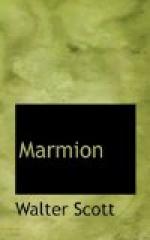’The ancient bridge of Twisel, by which the English crossed the Till, is still standing beneath Twisel Castle, a splendid pile of Gothic architecture, as now rebuilt by Sir Francis Blake, Bart., whose extensive plantations have so much improved the country around. The glen is romantic and delightful, with steep banks on each side, covered with copse, particularly with hawthorn. Beneath a tall rock, near the bridge, is a plentiful fountain, called St. Helen’s Well.’—Scott.
That James was credited by his contemporaries with military skill and ample courage will be seen by reference to Barclay’s ’Ship of Fooles,’ formerly referred to. The poet proposes a grand general European movement against the Turks, and suggests James iv as the military leader. The following complimentary acrostic is a feature of the passage:—
’I n prudence
pereles is this moste comely kinge;
A nd as for his
strength and magnanimitie
C onceming his
noble dedes in every thinge,
O ne founde on
grounde like to him can not be.
B y birth borne
to boldenes and audacitie,
U nder the bolde
planet of Mars the champion,
S urely to subdue
his enemies eche one.’
line 583. Sullen is admirably descriptive of the leading feature in the appearance of the Till just below Twisel Bridge. No one contrasting it with the Tweed at Norham will have difficulty in understanding the saying that:—
‘For a’e man that Tweed droons, Till droons three.’
Stanza xx. line 608. The earlier editions have vails, ‘lowers’ or ‘checks’; as in Venus and Adonis, 956, ‘She vailed her eyelids.’ The edition of 1833 reads ’vails, contr. for ‘avails.’
line 610. Douglas and Randolph were two of Bruce’s most trusted leaders.
line 611. See anecdote in ‘Border Minstrelsy,’ ii. 245 (1833 ed.), with its culmination, ‘O, for one hour of Dundee!’ Cp. ’Pleasures of Hope’ (close of Poland passage):—
’Oh! once again
to Freedom’s cause return
The Patriot Tell—the
Bruce of Bannockburn!’
and Wordsworth’s sonnet, ‘In the Pass of Killicranky,’ in which the aspiration for ‘one hour of that Dundee’ is prompted by the fear of an invasion in 1803.
Stanza xxi. line 626. Hap what hap, come what may. Cp. above ’tide what tide,’ iii. 416.
line 627. Basnet, a light helmet.
Stanza xxiii. line 682. ’The reader cannot here expect a full account of the Battle of Flodden: but, so far as is necessary to understand the romance, I beg to remind him, that, when the English army, by their skilful countermarch, were fairly placed between King James and his own country, the Scottish monarch resolved to fight; and, setting fire to his tents, descended from the ridge of Flodden to secure the neighbouring eminence of Brankstone, on which that village is built. Thus the two armies met, almost without seeing each other, when, according to the old poem of “Flodden Field,”—




